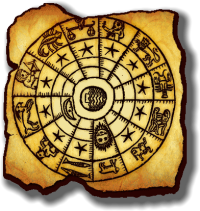 The Golden Threads Trilogy is set on the world of Niya-Yur which was established 15,000 years ago by the combined races of the Duianna Empire. The Imperial time measurements were a blend of the calendars used by the various races. The year of the great migration was universally adopted as year zero by all races. Also, Niya-Yur, being created at the height of the Duianna Empire’s influence, made the Imperial calendar the primary calendar for all the new nations.
The Golden Threads Trilogy is set on the world of Niya-Yur which was established 15,000 years ago by the combined races of the Duianna Empire. The Imperial time measurements were a blend of the calendars used by the various races. The year of the great migration was universally adopted as year zero by all races. Also, Niya-Yur, being created at the height of the Duianna Empire’s influence, made the Imperial calendar the primary calendar for all the new nations.
Extremely ancient records, available only in Gracia, provide connections to the origins. However, the 15,000 years since the great migration, as well as the chaos of the great migration has caused the loss of many critical references.
According to an ancient pre-migration tome, the time on Niya-Yur is measured roughly the same as it was in all races’ histories, which is to say that it is based on evenly dividing one complete rotation of the planet into smaller and smaller units of time. Intriguingly, this same tome suggests the races of Niya-Yur do not have a common home. The reference clearly states rotational values and names of planets for each of the major races. Therefore, each race originates from a home planet which has days slightly longer or shorter from Niya-Yur. For example, humans come from the legendary world called Terra. The tome states that Niya-Yur rotates on its axis slightly slower, making the Niya-Yur second about 1.1 Terra seconds. That minute difference means that humans have 2.4 marks additional time in the twenty-four mark day.
Note that only the measurements of Niya-Yur’s rotation and orbital speeds can be confirmed. The tome provides precise measurements of Niya-Yur lending to its accuracy. However, the precision of the tome’s measurements remain in question as they are to an order of measurement unattainable even by modern scientific tools.
Time Terms:
Second: is the smallest unit of time measurable by available clocks and is of time equal to one-sixtieth of a minute.
Minute: A period of time equal to 60 seconds or a 60th of an mark.
Mark: One of the 24 equal parts of a day. The name ‘mark’ is based on the tick marks used on all clocks
Day: The 24-mark period during which Niya-Yur completes one rotation on its axis.
Week: A period of seven days. The Imperial names for the days are Solidi (Sunday), Lundi (Monday), Martidi (Tuesday), Merdi (Wednesday), Iodi (Thursday), Vendi (Friday), and Saturdi (Saturday).
| Day of Week | Imperial Name | Terra Name |
| 1 | Solidi | Sunday |
| 2 | Lundi | Monday |
| 3 | Martidi | Tuesday |
| 4 | Merdi | Wednesday |
| 5 | Iodi | Thursday |
| 6 | Vendi | Friday |
| 7 | Saturdi | Saturday |
Cycle: A unit of time corresponding approximately to one cycle of the moon’s phases or about thirty days or four weeks.
Year: The period of time during which Niya-Yur completes a single revolution. The Imperial calendar is broken into four seasons starting with spring. The month names for each season are spring: Menadyt (April), Tarudyt (May), Nanadyt (June); summer: Samudyt (July), Patredyt (August), Innadyt (September); fall: Nabudyt (October), Kishadyt (November), Lahmudyt (December); and winter: Sharludyt (Jan), Ankidyt (February), Ninurdyt (March).
| Cycle | Season | Imperial Name | Terra Name |
| 1 | Spring | Menadyt | April |
| 2 | Tarudyt | May | |
| 3 | Nanadyt | June | |
| 4 | Summer | Samudyt | July |
| 5 | Patredyt | August | |
| 6 | Innadyt | September | |
| 7 | Fall | Nabudyt | October |
| 8 | Kishadyt | November | |
| 9 | Lahmudyt | December | |
| 10 | Winter | Sharludyt | January |
| 11 | Ankidyt | February | |
| 12 | Ninurdyt | March |
The Golden Threads Trilogy books are:
Wow, I’m a bestselling author! You can find all my books on Amazon (http://amazon.com/author/lartra)!



